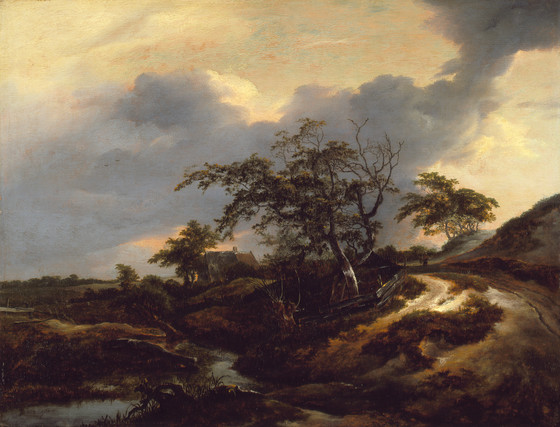Sir Edward Henry Page-Turner (d. 1874), 6th Bart., by inheritance to his wife; Mary Ann Otway (d. 1902), Lady PageTurner, Battlesden House, Bedfordshire, and Brighton, East Sussex.(1) [Charles Sedelmeyer Gallery, Paris].(2) Maurice Edouard Kann (1839–1906), Paris (sale, Paris, Galerie Georges Petit, 9 June 1911, lot 58, as “Le Tertre,” sold for 40,500 frs. to);(3) [Abraham Preyer, The Hague].(4) [Frederik Muller & Cie, Amsterdam]. August Janssen (1845/46–1918), Amsterdam, in 1913.(5) [Kunsthandel J. Goudstikker, Amsterdam and The Hague, by 1919, until at least 1922, as “Le Tertre” ].(6) H[endricus] E[gbertus] Ten Cate (1868–1955), Amelo, the Netherlands, by 1928.(7) [Rosenberg and Stiebel, Inc., New York, in 1951 (probably owned in shares with William Hallsborough Gallery, London, 1957)(8) sold 1958 to];(9) [J. Böhler, Munich and Lucerne].(10) Howard F. Ahmanson (1906–1968), Los Angeles, to his former wife; Mrs. Dorothy Grannis Sullivan (1908–1979), Newport Beach, CA, gift 1975 to; LACMA.
Footnotes
(1) She was later married to Thomas Isaac Guest.
(2) A vermilion wax seal on the back of the panel indicates that it was with Sedelmeyer, but it is not listed in the Sedelmeyer catalogues between 1894 and 1913.
(3) Maurice Kann and his brother Rudolfe Kann (1845–1905) owned adjacent houses in Paris, in which they displayed their collections of Old Master paintings, many of which subsequently entered major American museums. See Amy L. Walsh, “Kann, Rodolphe (Rudolf),” in Grove Art Online, first published 1996.
(4) According to Slive 2001, no. 604. Preyer was probably acting as an agent for Muller. Regarding Preyer, aka Preijer, see Hirschmann 1923.
(5) According to Goudstikker 1919. According to Hirschmann 1920, pp. 1–2, August Janssen formed his collection within ten years. The high point of collecting was 1912–13. He bought from Galerie Steengracht and often used the firm of Frederik Muller & Cie and middlemen.
(6) Possibly purchased from Janssen, whom Goudstikker (1919) mentions as the most recent owner, 1913. Listed as the lender of the painting to the 1922 exhibition Udstilling af aeldre og nyere Hollandsk malerkunst in Copenhagen, which was actually a sale.
(7) Rosenberg 1928, no. 523a, lists Ten Cate, a textile manufacturer and collector, as the owner. The painting does not appear in the 1955 catalogue of Ten Cate’s collection.
(8) Possibly owned in shares with Rosenberg and Stiebel, who owned the painting in November 1951 and again in 1958. William Suhr (1896–1984), Photo Archive, Getty Research Institute, file 27-3, notes that Suhr cleaned the painting in 1951 for Rosenberg and Stiebel.
(9) Letter from Kunsthandlung Julius Böhler, 19 September 2000 (Ruisdael object file, Department of European Painting and Sculpture, LACMA). 10 Advertised in Die Weltkunst 7 (1958).
(10) Advertised in Die Weltkunst 7 (1958).



